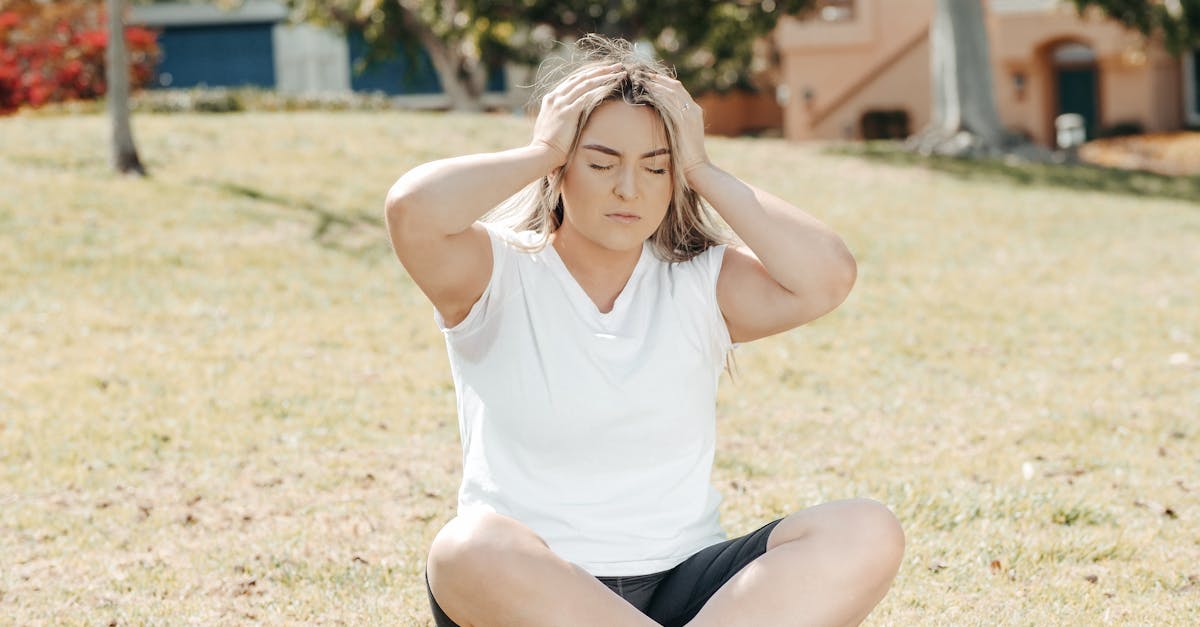Suffering from migraines and sleepless nights? Discover how better rest can transform your life.
In Short: Migraines, Sleep, and You—understanding the connection can help you break free from persistent migraine pain and improve your overall well-being. By embracing effective sleep habits through our innovative methods, you can significantly reduce tension headaches and identify migraine triggers that disrupt your rest. Pulse Align offers practical strategies that promote restful sleep, allowing you to reclaim your nights and enjoy enhanced health. Ready to experience the benefits of this holistic approach? Contact Pulse Align to learn more today!
Are you struggling with lower back pain and poor posture?
Did you know that the relationship between migraines, sleep, and you is critical for achieving restful nights? Studies show that managing migraine pain can significantly improve sleep quality, making it essential to explore natural headache remedies. At Pulse Align, we focus on creating tailored solutions that not only address headache causes and migraine triggers but also foster better sleep hygiene practices. By integrating approaches to manage tension headaches and incorporate a migraine diet, we pave the way for a more restful experience each night. Discover how our commitment to headache relief can transform your nightly rest and rejuvenation, making it easier to meet each day with vitality and clarity.

The connection between sleep and general well-being is often overlooked, yet it’s a crucial factor for many individuals facing headaches and other everyday discomforts. The right approach to sleep hygiene not only enhances your sleep quality but can also significantly influence your overall health. At Pulse Align, our gentle and innovative methods focus on posture improvement and neuromuscular recalibration to help clients attain a more balanced state and encourage deeper, restorative nights.
Sleep is a complex process influenced by various factors, including muscle tone and body alignment. Our team at Pulse Align is dedicated to providing a holistic approach to wellness that leverages gentle stimulation techniques to promote proper postural alignment. Through this approach, we help clients restore natural balance, which may lead to improved sleep quality and reduced discomfort that could interfere with a peaceful night’s rest.
Many clients have shared their transformative experiences with our methods, emphasizing how a focus on muscle tone symmetry naturally leads to overall well-being. For instance, clients have noted the way our sessions have assisted them in improving posture naturally while fostering relaxation and reducing daily tension. They often express feeling more at ease after participating in our tailored programs and a notable improvement in their sense of balance and stability.
If you’re in search of a welcoming environment that supports your wellness journey, consider booking a consultation with Pulse Align. Our services are designed for individuals of all ages, making it a family-friendly option, whether in Montreal, La Prairie, Chicoutimi, Charlesbourg, Saint-Jérôme, or Panama City. Experience the gentle guidance we offer at Pulse Align and discover how we can help you on your path toward better well-being. Learn more about us and find a clinic close to you here.
- Sleep Positions: Discover the best positions to alleviate tension and prevent migraine triggers.
- Sleep Hygiene: Prioritize good habits, including consistent bedtime routines for better rest.
- Breathing Exercises: Learn techniques to calm the mind and promote quicker sleep onset.
- Mindfulness: Incorporate meditation to release daily stressors that might interfere with sleep.
- Natural Light Exposure: Engage with daylight to regulate your body clock and improve sleep quality.
- Journaling: Track sleep patterns and migraine occurrences to identify connections and triggers.
- Healthy Diet: Focus on anti-inflammatory foods to potentially reduce migraine frequency.
- Relaxation Techniques: Utilize hot baths or warm showers to unwind before bedtime.

Chronic migraines and sleep disturbances are increasingly recognized as interconnected challenges affecting many individuals. By understanding the profound relationship between migraine pain and sleep quality, we can explore how Pulse Align’s holistic approach provides headache relief through improved neuromuscular health and posture improvement. This article will outline actionable strategies to foster more restful nights and empower you with essential tools for better health.
The Sleep-Migraine Connection
Research shows that sleep disturbances can act as migraine triggers, exacerbating pain and discomfort. Many individuals suffering from tension headaches or even severe chronic migraines report that an inconsistent sleep schedule can amplify their symptoms. Adequate sleep is crucial for headache management, making it essential to cultivate better sleep habits.
Posture Improvement and Neuromuscular Health
One significant aspect of achieving better sleep is maintaining proper posture, both during the day and while sleeping. Posture correction can significantly alleviate tension that contributes to headaches. For example, a slouched position can lead to muscle strain around the neck and back, leading to painful symptoms. By engaging in core strengthening exercises and trunk exercises, individuals can enhance their alignment and reduce pressure points that might contribute to migraines, enhancing overall sleep quality.
Essential Tips for Better Sleep Hygiene
To encourage restful nights, consider adopting some fundamental sleep hygiene practices. Keep a journal by your bedside to jot down thoughts that may hinder relaxation. Establish a bedtime routine that promotes calmness, such as a warm bath or incorporating natural headache remedies like essential oils. Moreover, disconnecting from screens two hours before sleep can significantly reduce exposure to blue light, enhancing sleep quality and minimizing nausea with headache.
The Role of Dietary Choices
Understanding your migraine diet is vital in addressing potential headache causes. Certain foods can be direct migraine triggers. For example, research indicates that aged cheeses and processed meats may incite attacks. A personalized dietary plan that eliminates these triggers can lead to better sleep and reduced headache frequency. Consulting with experts at Pulse Align can help you craft a personalized approach to eating that supports your overall well-being.
Call to Action: Embrace Holistic Solutions
At Pulse Align, we believe that effective migraine management hinges on embracing holistic, personalized solutions. Whether you’re struggling with aura migraines, menstrual migraines, or even vestibular migraines, our team is dedicated to helping you find balance through neuromuscular recalibration that supports both head and neck alignment.
Don’t wait for your next migraine attack to take action. Book a consultation with Pulse Align today to discover how tailored exercise plans, shockwave therapy, and expert guidance can transform your sleep experience and alleviate migraine discomfort.
| Aspect | Description |
|---|---|
| Connection | Chronic migraines can severely disrupt sleep patterns. |
| Quality Sleep | Adequate sleep improves overall migraine management. |
| Sleep Environment | Creating a calming sleep space is crucial for rest. |
| Position Matters | Optimal sleeping positions can reduce migraine triggers. |
| Digital Detox | Limiting screen time before bed enhances sleep quality. |
| Breathing Techniques | Utilizing breathing exercises can facilitate quicker sleep. |
| Professional Guidance | Consulting health experts can clarify sleep-related issues. |
| Holistic Approach | Pulse Align emphasizes whole-body wellness for better relief. |
| Sleep Diary | Keeping a diary can help identify patterns impacting sleep. |

Transformative Wellness Journeys: Clients Sharing Their Experiences with Pulse Align
Clients from various regions, including Mont-Royal and Châteauguay, have voiced profound transformations after engaging with the holistic methodologies offered by Pulse Align. Many have reported feeling a significant reduction in migraine frequency and intensity, allowing them to reclaim their daily lives and enjoy restful nights. The unique focus on neuromuscular health has empowered them to understand their bodies better and acknowledge the connection between migraines and sleep habits.
In Deux-Montagnes, one client shared, “Before I discovered Pulse Align, I felt trapped in a cycle of pain and sleepless nights. Their approach not only relieved my headaches but also rejuvenated my overall well-being. I now wake up refreshed, ready to face my day!” This testimonial reflects the positive effects that come from working on recentering the body and enhancing sleep quality.
Another client from Sainte-Marie mentioned, “The staff at Pulse Align truly understand the intricate link between migraines and restorative sleep. Since I began my wellness journey there, I’ve learned how to create a sleep environment that nurtures my body and mind. The results have been nothing short of remarkable.” This story highlights how supportive practices at Pulse Align can help individuals navigate and alleviate the struggles associated with chronic headaches.
In regions like Terrebonne and Chicoutimi, many clients appreciate the tailored guidance provided to enhance their sleep hygiene and wellness. They have felt empowered to take charge of their health journeys, firmly believing that Pulse Align works in harmony with their healthcare teams, making strides toward holistic recovery a reality.
As you seek ways to enhance your overall well-being, consider visiting our clinics and experience firsthand the impact of our services in your local area. Explore the numerous benefits that clients have discovered while working with Pulse Align on their wellness journeys by clicking on Our Clinics.
The Connection Between Sleep and Headaches
Understanding the intricate relationship between migraines and sleep habits is crucial for those suffering from chronic headaches. Integrating effective sleep hygiene practices can significantly enhance overall well-being. Features such as adopting a good sleeping position can alleviate tension, reduce the likelihood of migraine episodes, and improve sleep quality. When you wake up rested, you are better equipped to face the day.
Strategies for Enhancing Sleep
To further establish healthier sleep routines, consider keeping a pen bedside to jot down any thoughts that may disrupt your peace of mind. Taking a hot bath before bed not only relaxes the muscles but also prepares the body for deeper slumber. Additionally, disconnecting from screens two hours prior to bedtime can mitigate the adverse effects of blue light exposure, paving the way for improved sleep quality.
Prioritizing Sleep: Your Best Advocate
Recognizing your own sleep needs, such as the timing and duration of your rest, is essential. Adults typically require about 6 to 8 hours of sleep nightly. By spending time outdoors in natural light, you reinforce your body’s natural circadian rhythms, thus fostering a healthier sleep cycle.
Our Mission
At Pulse Align, our mission is to deliver evidence-based, client-centered treatments that address the underlying causes of pain and dysfunction. By integrating advanced techniques and technologies, we strive to empower each person to take control of their health, ensuring a high standard of care, lasting relief, and an improved quality of life.
Discover more about our approach and available services at www.pulsealign.com and find a location near you here.
Enhance Your Recovery with TAGMED’s Spinal Decompression Technology
TAGMED’s advanced Spinal Decompression Therapy offers a revolutionary non-surgical solution designed specifically to address moderate-to-severe disc issues such as herniated discs and bulging discs. This specialized technique works by gently reducing pressure on the affected discs and nerves, which significantly enhances mobility, alleviates pain, and supports the body’s natural healing process. If traditional therapies have reached their limits, delve into how TAGMED’s evidence-based decompression approach can assist you in resuming an active, comfortable life.
Have you tried conventional treatments and still struggle with persistent back pain due to a severe disc condition?
Mechanism of Action
At the core of TAGMED’s neurovertebral decompression is a method that applies a controlled, progressive traction force to the spine. This approach increases the space between vertebrae, reduces pressure on intervertebral discs and nerve roots, and promotes improved fluid circulation in the affected area. Such physiological changes help lower inflammation and relieve pain, presenting a reliable, non-invasive solution for individuals suffering from chronic back pain or conditions associated with degenerative disc disease.
Specific Benefits
This non-invasive approach effectively alleviates chronic pain and symptoms linked to issues like spinal stenosis and disc protrusion. By reducing pressure on the nerve structures and optimizing fluid circulation around the discs, TAGMED’s therapy accelerates recovery and enhances quality of life for diverse patients seeking relief from persistent discomfort linked to conditions such as sciatica or facet syndrome.
Comparison with Other Treatments
When comparing TAGMED’s neurovertebral decompression technology with other common treatments, the distinctions become clear. Conventional methods like pain medications, corticosteroid injections, and even surgical interventions often involve invasive procedures and associated risks. Neurovertebral decompression, however, offers an effective alternative without the need for such interventions. This technique minimizes medication-related side effects and offers patients a potentially expedited recovery, providing a compelling choice for those seeking safer, evidence-based solutions.
Case Studies or Testimonials
Numerous real-world examples exist of patients who have experienced significant benefits from TAGMED’s neurovertebral decompression for their chronic pain and related symptoms. Testimonials frequently highlight lasting pain relief, faster resumption of daily activities, and a noticeable reduction in dependence on pharmaceuticals. These firsthand accounts illustrate the tangible outcomes and practical advantages that this therapeutic approach offers.
If you’re navigating the complex relationship between migraines and sleep, Pulse Align offers a holistic approach that focuses on your overall well-being. With a commitment to enhancing wellness through neuromuscular recalibration, we aim to help you improve your posture, reduce discomfort, and promote natural pain relief. Our methodology encourages a path toward better sleep quality and vibrant health.
Clients often share their positive experiences with us, remarking on the newfound sense of comfort and mobility they have gained with our techniques. By prioritizing your journey towards holistic health, Pulse Align provides a nurturing environment where every individual can find relief and support. It’s all about listening to your body’s needs and encouraging its natural healing abilities.
We invite you to discover the Pulse Align difference today. Schedule your consultation now and take the first step towards a healthier, more balanced you. Embrace the opportunity to transform your well-being and experience the restorative power of sleep coupled with our support. Together, let’s pave the way for restful nights and brighter days ahead.

Do you suffer from a chronic condition that responds little or not at all to conservative treatments?
At Pulse Align, we understand that life can sometimes bring challenges that affect your overall sense of well-being. Our innovative, non-invasive method utilizes gentle, imperceptible pulses to help restore your body’s natural balance and posture. This approach can lead to a decrease in muscle and joint tension, allowing for a more harmonious bodily experience. By focusing on the natural realignment and recalibration of muscle tone, we aim to enhance your comfort and promote restful nights.
What makes our approach unique is that Pulse Align does not directly address discomfort or conditions. Instead, we facilitate the body’s own ability to recalibrate itself naturally. Many clients have found that, through our sessions, they experience significant improvements in comfort and posture, contributing to an overall sense of rejuvenation. Our method emphasizes the body’s inherent capabilities, allowing for amazing transformations without direct interventions.
We pride ourselves on offering a personalized experience at Pulse Align. Each client’s journey is unique, and we celebrate the positive feedback we receive. Many have shared testimonials highlighting improvements in tension around the neck and back, as well as overall wellness. Clients often report feeling more balanced and aligned, contributing to an enhanced sense of daily ease. Our team is dedicated to supporting our clients on their path toward improved well-being.
We invite you to explore how Pulse Align can fit into your wellness journey and that of your family. Whether you are located in La Prairie, Mont-Royal, Terrebonne, or beyond, our clinics are here to serve you. Our approach complements, but does not replace, any ongoing healthcare services you may have. We encourage you to book a consultation today and experience the difference for yourself. To learn more and find a location near you, visit Pulse Align and take the first step towards a renewed sense of balance and well-being.
Frequently Asked Questions
Headache and Migraine
- Do coenzyme Q10 or magnesium help?Some studies suggest magnesium or coenzyme Q10 supplements may reduce migraine frequency.
- Do sunglasses help during a migraine?Yes, they reduce light sensitivity and partially alleviate symptoms.
- How to differentiate a migraine from a tension headache?Tension headaches cause diffuse, moderate pressure. Migraines are often more severe, pulsating, one-sided, and accompanied by associated symptoms.
- Do massages help with headaches?A gentle scalp, neck, or shoulder massage can relieve muscle tension and ease a headache.
- Do migraine medications cause dependence?Not typically, but frequent use of analgesics can lead to rebound headaches.
- Is an aura always present?No, only about 20% of migraine sufferers experience an aura before the attack.
- Do children get migraines?Yes, children can experience migraines, often shorter but just as painful.
- Can relaxation techniques help?Yes, meditation, yoga, deep breathing, or biofeedback can reduce frequency and intensity of attacks.
- Are blue-light filtering screens useful?They reduce eye strain, potentially lowering headache risk.
- How long does a migraine last?An untreated migraine can last from a few hours to three days.
Ethan Dubois is dedicated to shining a light on the hidden struggles of chronic headaches. As a Headache Awareness Advocate at Pulse Align, he combines compassionate storytelling with cutting-edge research to bring clarity, comfort, and hope to those affected. Ethan’s mission is to empower readers with knowledge, break through stigma, and foster a supportive community where every voice is heard. When he’s not crafting insightful articles, Ethan can be found exploring the latest wellness trends, sharing practical coping strategies, or simply lending a listening ear to those in need. His heartfelt approach and unwavering commitment to awareness make him a trusted ally for anyone navigating life with headaches.
References
- Martínez-Merinero, P., Aneiros Tarancón, F., Montañez-Aguilera, J., Nuñez-Nagy, S., Pecos-Martín, D., Fernández-Matías, R., Achalandabaso-Ochoa, A., Fernández-Carnero, S., & Gallego-Izquierdo, T. (2021). Interaction between pain, disability, mechanosensitivity and cranio-cervical angle in subjects with cervicogenic headache: A cross-sectional study. Journal of Clinical Medicine, 10(1), 159. https://www.mdpi.com/2077-0383/10/1/159
- Balaban, M., Celenay, S. T., Lalecan, N., Akan, S., & Kaya, D. O. (2024). Morphological and mechanical properties of cervical muscles in fibromyalgia with migraine: A case-control study. Musculoskeletal Science and Practice, 74, 103185. https://www.sciencedirect.com/science/article/pii/S2468781224002807
- Hvedstrup, J., Kolding, L. T., Ashina, M., & Schytz, H. W. (2020). Increased neck muscle stiffness in migraine patients with ictal neck pain: A shear wave elastography study. Cephalalgia, 40(6), 565–574. https://doi.org/10.1177/0333102420919998
- Yu, Z., Wang, R., Ao, R., & Yu, S. (2019). Neck pain in episodic migraine: a cross-sectional study. Journal of Pain Research, Volume 12, 1605–1613. https://doi.org/10.2147/JPR.S200606
- Zwart, J. (1997). Neck Mobility in Different Headache Disorders. Headache: The Journal of Head and Face Pain, 37(1), 6–11. https://doi.org/10.1046/j.1526-4610.1997.3701006.x
- Bjarne, B. (2024). NECK MUSCLE ELASTICITY IN CERVICOGENIC HEADACHE PATIENTS MEASURED BY SHEAR WAVE ELASTOGRAPHY [PhD Thesis, Ghent University]. https://libstore.ugent.be/fulltxt/RUG01/003/202/979/RUG01-003202979_2024_0001_AC.pdf
- Pradhan, S., & Choudhury, S. S. (2018). Clinical characterization of neck pain in migraine. Neurology India, 66(2), 377–384. https://journals.lww.com/neur/fulltext/2018/66020/clinical_characterization_of_neck_pain_in_migraine.19.aspx
- Fernández-de-las-Peñas, C., Madeleine, P., Caminero, A., Cuadrado, M., Arendt-Nielsen, L., & Pareja, J. (2010). Generalized Neck-Shoulder Hyperalgesia in Chronic Tension-Type Headache and Unilateral Migraine Assessed by Pressure Pain Sensitivity Topographical Maps of the Trapezius Muscle. Cephalalgia, 30(1), 77–86. https://doi.org/10.1111/j.1468-2982.2009.01901.x
- Ashina, S., Bendtsen, L., Lyngberg, A. C., Lipton, R. B., Hajiyeva, N., & Jensen, R. (2015). Prevalence of neck pain in migraine and tension-type headache: A population study. Cephalalgia, 35(3), 211–219. https://doi.org/10.1177/0333102414535110
- Luedtke, K., Starke, W., & May, A. (2018). Musculoskeletal dysfunction in migraine patients. Cephalalgia, 38(5), 865–875. https://doi.org/10.1177/0333102417716934
- Al-Khazali, H. M., Al-Sayegh, Z., Younis, S., Christensen, R. H., Ashina, M., Schytz, H. W., & Ashina, S. (2024). Systematic review and meta-analysis of Neck Disability Index and Numeric Pain Rating Scale in patients with migraine and tension-type headache. Cephalalgia, 44(8), 03331024241274266. https://doi.org/10.1177/03331024241274266
- Lin, L.-Z., Yu, Y.-N., Fan, J.-C., Guo, P.-W., Xia, C.-F., Geng, X., Zhang, S.-Y., & Yuan, X.-Z. (2022). Increased stiffness of the superficial cervical extensor muscles in patients with cervicogenic headache: A study using shear wave elastography. Frontiers in Neurology, 13, 874643. https://www.frontiersin.org/articles/10.3389/fneur.2022.874643/full
- Calhoun, A. H., Ford, S., Millen, C., Finkel, A. G., Truong, Y., & Nie, Y. (2010). The Prevalence of Neck Pain in Migraine. Headache: The Journal of Head and Face Pain, 50(8), 1273–1277. https://doi.org/10.1111/j.1526-4610.2009.01608.x
- Choi, S.-Y., & Choi, J.-H. (2016). The effects of cervical traction, cranial rhythmic impulse, and Mckenzie exercise on headache and cervical muscle stiffness in episodic tension-type headache patients. Journal of Physical Therapy Science, 28(3), 837–843. https://www.jstage.jst.go.jp/article/jpts/28/3/28_jpts-2015-893/_article/-char/ja/
- Kolding, L. T., Do, T. P., Ewertsen, C., & Schytz, H. W. (2018). Muscle stiffness in tension-type headache patients with pericranial tenderness: A shear wave elastography study. Cephalalgia Reports, 1, 2515816318760293. https://doi.org/10.1177/2515816318760293
- Florencio, L. L., De Oliveira, A. S., Carvalho, G. F., Tolentino, G. D. A., Dach, F., Bigal, M. E., Fernández‐de‐las‐Peñas, C., & Bevilaqua Grossi, D. (2015). Cervical Muscle Strength and Muscle Coactivation During Isometric Contractions in Patients With Migraine: A Cross‐Sectional Study. Headache: The Journal of Head and Face Pain, 55(10), 1312–1322. https://doi.org/10.1111/head.12644
- Fernández-de-las-Peñas, C., Cuadrado, M., & Pareja, J. (2006). Myofascial Trigger Points, Neck Mobility and Forward Head Posture in Unilateral Migraine. Cephalalgia, 26(9), 1061–1070. https://doi.org/10.1111/j.1468-2982.2006.01162.x
- Fernández‐de‐las‐Peñas, C., Cuadrado, M. L., & Pareja, J. A. (2007). Myofascial Trigger Points, Neck Mobility, and Forward Head Posture in Episodic Tension‐Type Headache. Headache: The Journal of Head and Face Pain, 47(5), 662–672. https://doi.org/10.1111/j.1526-4610.2006.00632.x
- Al-Khazali, H. M., Younis, S., Al-Sayegh, Z., Ashina, S., Ashina, M., & Schytz, H. W. (2022). Prevalence of neck pain in migraine: A systematic review and meta-analysis. Cephalalgia, 42(7), 663–673. https://doi.org/10.1177/03331024211068073
- Aoyama, N. (2021). Involvement of cervical disability in migraine: a literature review. British Journal of Pain, 15(2), 199–212. https://doi.org/10.1177/2049463720924704




